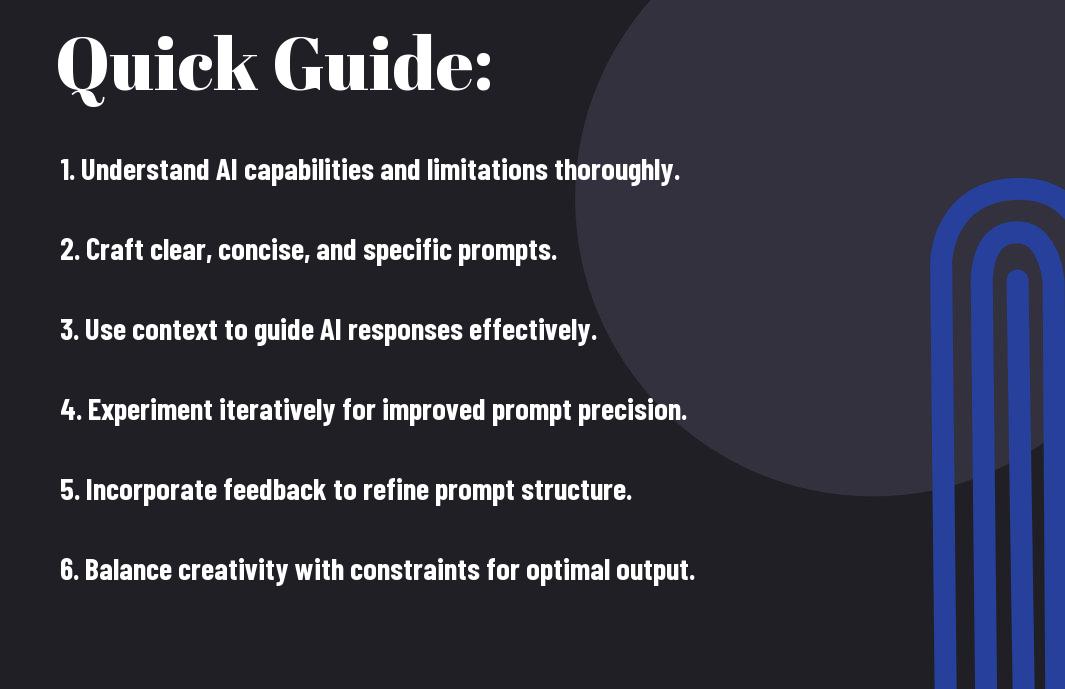Engineering effective interactions with agentic AI can transform your experiences and results. By mastering prompt engineering, you can significantly enhance your AI’s responsiveness and accuracy, ensuring you achieve your desired outcomes. This guide will outline important techniques, common pitfalls, and the benefits of optimizing your approach. With the right strategies, you can unlock the full potential of your AI tools. For an in-depth exploration, consider checking out Optimizing AI Prompt Engineering: A Practical Guide to ….
Key Takeaways:
- Effective prompt engineering is important for achieving accurate and relevant responses from agentic AI, enhancing the overall user experience.
- Iterative testing and refinement of prompts can lead to improved interaction outcomes, showcasing the importance of user experimentation in the process.
- Understanding the capabilities and limitations of AI models enables users to craft more precise prompts, maximizing the utility of the technology.
Crafting Engaging Prompts That Resonate
Engaging prompts are those that draw in the user, fostering deeper interaction with agentic AI. Consider the emotional tone and context when crafting your prompts. Using evocative language or relatable scenarios can create connections that enhance engagement. Strong prompts often guide the AI toward the desired direction while allowing for flexibility in its responses. For instance, rather than asking, “What is the weather?” try, “How does the beautiful sunshine today make you feel?” This subtle pivot can lead to richer, more meaningful interactions.
Analyzing User Intent for Tailored Responses
Understanding user intent forms the backbone of effective prompt engineering. By discerning what the user is truly seeking, you can tailor your prompts to elicit responses that are not only relevant but also personalized. Ask yourself questions like, “Are they looking for facts, opinions, or advice?” This insight allows you to shape interactions that resonate more deeply, creating a satisfying and productive user experience.
The Importance of Clarity and Specificity in Language
Clarity and specificity in your prompts can significantly improve the quality of responses from agentic AI. Ambiguity can lead to confusion and misinterpretation, resulting in off-target answers. For example, instead of asking, “Tell me about Paris,” specify your interest: “What are the top three historical landmarks to visit in Paris?” This clarity ensures that the AI understands your request and delivers concise, relevant information. A well-defined prompt not only eliminates uncertainty but also allows the AI to tap into its full potential.
Crafting clear and specific prompts eliminates the risk of vague responses, enhancing the overall conversation quality. This precision guides the AI in processing your request, allowing it to focus on particular aspects that matter most to you. A well-structured question or statement acts like a roadmap, helping the AI navigate vast data efficiently. For instance, accompanying your request with context—for example, mentioning whether you’re planning a trip or conducting research—creates a layered understanding, leading to a more tailored response. Engaging with agentic AI becomes more effective when the dialog is direct and specific.


Unlocking AI’s Full Potential: Techniques to Enhance Interaction
Enhancing your interaction with agentic AI means diving deeper into advanced techniques that can vastly improve prompt engineering. Utilizing specific strategies and a clear understanding of context not only maximizes the AI’s responsiveness but can also unlock innovative applications across sectors. With your prompts fine-tuned and contextually rich, the possibilities for personalized and effective engagement expand considerably.
Strategies for Fine-Tuning Prompt Outcomes
Fine-tuning your prompts involves experimenting with language, structure, and detail. Use precise wording that aligns with your objectives; for instance, specify the desired tone—whether formal, casual, or technical. Adjusting question formats can yield different insights; open-ended queries often lead to more expansive responses, while closed questions may direct the AI towards specific solutions. Experimentation will help you understand what resonates best with your intended outcomes.
The Role of Context in Guiding AI Behavior
Context is a game-changer in shaping AI responses. Providing background details, situational information, and clear objectives ensures the AI interprets your prompts accurately. When prompts mirror the context of previous interactions or include relevant details, the AI can generate specific, tailored responses that align with your needs. For instance, referring back to a previous discussion within the same session allows the AI to connect the dots and deliver more cohesive insights.
Context acts as a framework that guides the AI’s understanding and response generation. For example, if you previously discussed the challenges of remote work, leveraging that context can lead AI to suggest tailored productivity tools or team-building strategies suited to your situation. By embedding context, you prompt the AI to draw from its extensive training on interconnected ideas and themes, producing responses that not only address your query but also resonate with your specific circumstances and objectives.
Navigating Common Pitfalls in Prompt Engineering
Effective prompt engineering requires awareness of typical missteps that can compromise communication with agentic AI. Avoiding these common pitfalls not only saves time but also enhances the quality of your interactions. For more insights on mastering AI communication, check out The Ultimate Guide to Prompt Engineering: Shaping AI with Precision.
Mistakes That Undermine Effective Communication
Simply asking vague or overly complicated questions can lead to frustrating outcomes. Using ambiguous language or lacking context diminishes the AI’s ability to produce meaningful responses. For example, instead of asking, “Tell me about it,” provide specific details that guide the AI toward your desired information. This clarity ensures you receive relevant output, making your interactions more efficient.
How to Recognize and Adapt to AI Limitations
Familiarizing yourself with AI’s constraints will significantly improve your prompts. Understanding factors like the AI’s knowledge cut-off, context sensitivity, and tendency for factual inaccuracies helps you adjust your requests accordingly. This awareness enables you to formulate questions that align better with its operational framework, leading to improved outcomes.
Recognizing AI limitations involves tuning into its recurring errors or blind spots. For instance, if the AI struggles with recent events or niche topics, craft your prompts to focus on areas within its training expertise. Consider specifying temporal contexts (e.g., “As of 2023”) or framing inquiries around broader themes. By actively adapting your prompts based on its known limitations, you can ensure a more productive and enriching interaction with the AI.
Real-World Applications: Transforming Industries with AI
Agentic AI is making waves across various industries, reshaping traditional business practices and creating innovative solutions. In healthcare, AI-driven systems are enabling predictive analytics for patient diagnoses, leading to timely interventions and improved outcomes. In finance, machine learning algorithms streamline fraud detection and automate trading, increasing efficiency and reducing risks. Retail businesses leverage AI to personalize customer experiences, enhancing engagement and loyalty. These applications demonstrate the profound impact of AI, not just as a tool, but as a transformative force across diverse sectors.
Breaking Down Success Stories in Business and Tech
Numerous companies illustrate the effectiveness of integrating agentic AI into their operations. For instance, Amazon‘s AI-powered recommendation system has significantly boosted sales by suggesting relevant products, leading to a 29% increase in revenue. Similarly, IBM’s Watson revolutionized cancer treatment with its ability to analyze vast data sets, enhancing diagnostic efficiency and paving the way for precision medicine. These cases reveal how successfully leveraging AI creates tangible value and competitive advantage.
Identifying Opportunities Across Various Sectors
Successful AI implementation goes beyond technology; it’s about spotting opportunities within your specific industry. The automotive sector is embracing AI for self-driving technologies, promising safer roads and reduced congestion. In agriculture, AI helps optimize crop yields through smart analytics, leading to sustainable practices. Moreover, logistics companies utilize AI for route optimization, directly impacting operational costs. These opportunities highlight the diverse landscape in which AI can thrive, inspiring you to explore how similar strategies can enhance your own industry.
In the healthcare realm, the potential to harness AI extends to areas such as health monitoring and personalized treatment, where data-driven insights can lead to tailored wellness plans. Additionally, the education sector is tapping into AI for personalized learning experiences, adapting curriculums based on student performance. These diverse applications emphasize that your ability to identify unique opportunities in your sector is paramount to maximizing the benefits of AI. By analyzing existing challenges and leveraging AI capabilities, you can unlock new pathways for innovation and growth that remain ahead of the competition.
The Future of Human-AI Collaboration: Trends to Watch
As AI technology continues to evolve, the future of human-AI collaboration looks promising, offering enhanced productivity and creativity. You can anticipate sophisticated AI systems that not only respond to prompts more effectively but also anticipate your needs, fostering deeper interactions. As organizations integrate AI tools into their workflows, expect advancements in areas such as natural language understanding and personalized user experiences. This partnership will not only streamline operations but also unlock new horizons for innovation across various sectors.
Emerging Technologies Shaping Prompt Engineering
Emerging technologies like transformer architectures, which power models like GPT-3, are revolutionizing prompt engineering. You can leverage advancements in quantum computing to boost processing capabilities, enabling more complex interactions in AI. Additionally, advancements in machine learning techniques are enhancing the adaptability of AI, allowing it to better understand your context and intent. By staying informed on these developments, you’ll be better positioned to refine your prompt engineering approach.
Ethical Considerations in Interactive AI Development
The rapid evolution of AI raises important ethical questions that demand your attention as you engage with these technologies. Issues like data privacy, bias in algorithms, and the potential for misuse underscore the need for responsible development practices in interactive AI. Safeguarding user data and minimizing harmful biases should be integral parts of your strategy, fostering trust between humans and AI.
As interactive AI systems become more sophisticated, ethical considerations must remain at the forefront of development. For instance, bias in AI algorithms can lead to unfair treatment of certain user demographics, which can damage trust and acceptance. You should advocate for transparency in AI processes and ensure that teams conduct rigorous testing to identify and mitigate bias. Additionally, by implementing feedback mechanisms, AI can learn from real-world interactions, better serving diverse user needs while maintaining ethical standards. These measures are not just best practices; they are vital for the sustainable integration of AI into society.
Summing up
Ultimately, mastering prompt engineering is necessary for optimizing your interactions with agentic AI. By understanding the principles outlined in this guide, you can enhance the effectiveness of your communications, ensuring that the AI understands your intentions clearly. With practice, you’ll refine your skills, leading to more accurate and relevant responses from the AI, ultimately maximizing the potential of these powerful tools in your projects.
Q: What is prompt engineering and why is it important for interacting with AI?
A: Prompt engineering is the process of designing and refining input prompts to effectively guide an AI model in generating desired outputs. It is important because AI models, especially those based on natural language processing, rely heavily on the input they receive. By carefully crafting prompts, users can improve the relevance, accuracy, and usefulness of the AI-generated responses, leading to more productive and insightful interactions.
Q: What techniques can be employed in prompt engineering to enhance AI responses?
A: Several techniques can be utilized in prompt engineering, including specificity, context provision, and iterative refinement. Specificity involves clearly defining the expected outcome, while context provision allows the AI to understand the background or framework within which it should operate. Iterative refinement entails testing different prompts and tweaking them based on the AI’s feedback to arrive at an optimal phrase that elicits the best overall response from the AI.
Q: How can users test and measure the effectiveness of different prompts when working with AI?
A: Users can test and measure prompt effectiveness through a process of experimentation and evaluation. This involves deploying different variations of prompts and systematically assessing the quality of responses based on criteria such as relevance, clarity, and completeness. Utilizing metrics such as user satisfaction scores or accuracy assessments can help in gauging the performance of each prompt. Additionally, keeping a record of the AI’s outputs related to each prompt allows users to identify patterns and insights that lead to improved future interactions.







